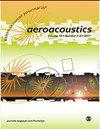Effect of 2D ice accretion on turbulent boundary layer and trailing-edge noise
IF 1.2
4区 工程技术
Q3 ACOUSTICS
引用次数: 1
Abstract
Trailing-edge noise is known to be sensitive to airfoil shapes, and ice accretion is one cause of an airfoil shape deformation. This paper investigates how trailing-edge noise is affected by the airfoil shape deformation due to ice accretion. The formation of ice-induced flow separation and the development of a turbulent boundary layer are analyzed to understand the correlation between the altered flow physics due to ice accretion inside the boundary layer and trailing-edge noise. The near-wall flow behind the leading-edge ice accretion is analyzed by using Reynolds-Averaged Navier Stokes CFD in OpenFOAM, and trailing-edge noise is investigated using an empirical wall pressure spectrum model in conjunction with Amiet’s trailing-edge noise theory. Validations of tools against measurement data are presented. Liquid water content, freestream velocity, and ambient temperature are varied to investigate the impact of flow conditions on the ice accretion shape and the resulting boundary layer flow characteristics at the trailing edge. It is found that a more significant leading edge deformation due to ice accretion generates larger ice-induced flow separation bubbles, which increases the trailing-edge boundary layer thickness. As a result, an increase in low- and mid-frequency noise is observed. The purpose of this paper is not only to understand the effect of ice accretion on trailing-edge noise but also to comprehensively analyze how flow physics inside the turbulent boundary layer is altered by the presence of various ice accretion shapes.二维积冰对湍流边界层和后缘噪声的影响
后缘噪声对翼型很敏感,结冰是翼型变形的原因之一。本文研究了机翼结冰变形对后缘噪声的影响。分析了冰引起的流动分离的形成和湍流边界层的发展,以了解边界层内结冰引起的流动物理变化与后缘噪声之间的相关性。在OpenFOAM中使用雷诺平均Navier-Stokes CFD分析了前缘结冰后的近壁流,并使用经验壁压谱模型结合Amiet的后缘噪声理论研究了后缘噪声。给出了工具相对于测量数据的验证。改变液态水含量、自由流速度和环境温度,以研究流动条件对结冰形状的影响以及由此产生的后缘边界层流动特性。研究发现,由于积冰引起的前缘变形更显著,会产生更大的冰诱导流分离气泡,从而增加后缘边界层的厚度。结果,观察到低频和中频噪声的增加。本文的目的不仅是了解积冰对后缘噪声的影响,而且还全面分析了各种积冰形状如何改变湍流边界层内的流动物理。
本文章由计算机程序翻译,如有差异,请以英文原文为准。
求助全文
约1分钟内获得全文
求助全文
来源期刊

International Journal of Aeroacoustics
ACOUSTICS-ENGINEERING, AEROSPACE
CiteScore
2.10
自引率
10.00%
发文量
38
审稿时长
>12 weeks
期刊介绍:
International Journal of Aeroacoustics is a peer-reviewed journal publishing developments in all areas of fundamental and applied aeroacoustics. Fundamental topics include advances in understanding aeroacoustics phenomena; applied topics include all aspects of civil and military aircraft, automobile and high speed train aeroacoustics, and the impact of acoustics on structures. As well as original contributions, state of the art reviews and surveys will be published.
Subtopics include, among others, jet mixing noise; screech tones; broadband shock associated noise and methods for suppression; the near-ground acoustic environment of Short Take-Off and Vertical Landing (STOVL) aircraft; weapons bay aeroacoustics, cavity acoustics, closed-loop feedback control of aeroacoustic phenomena; computational aeroacoustics including high fidelity numerical simulations, and analytical acoustics.
 求助内容:
求助内容: 应助结果提醒方式:
应助结果提醒方式:


